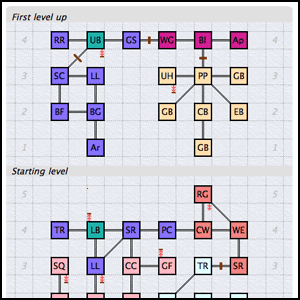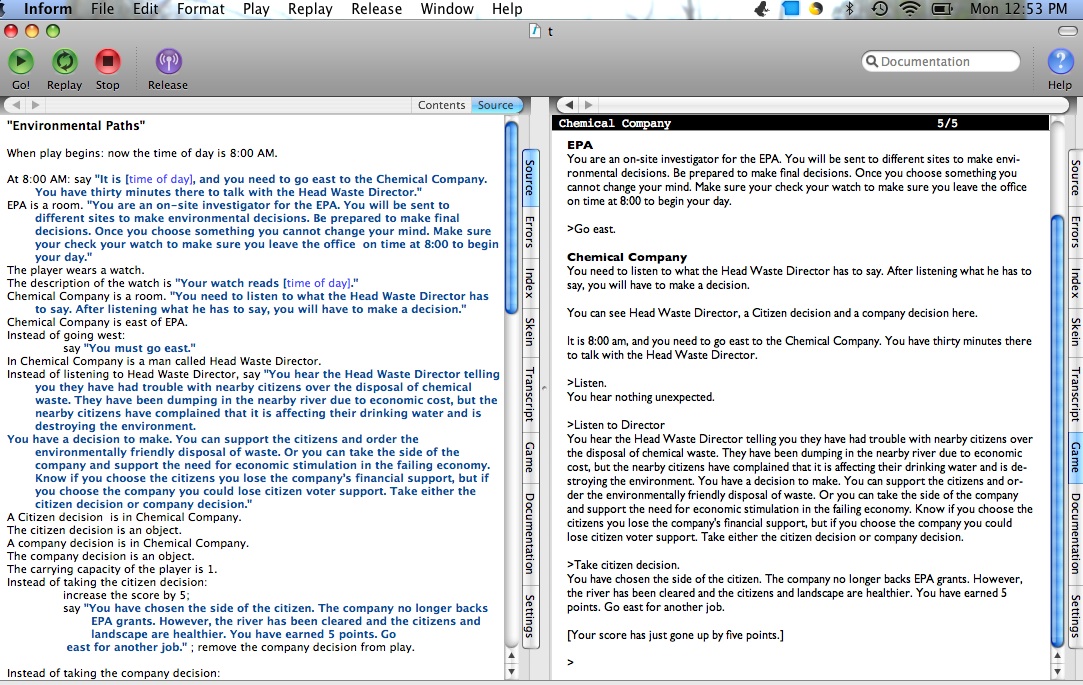
Image Credit:
In my “Critical Reading and Persuasive Writing” course last semester, I included an assignment that drew on Ian Bogost’s understanding of procedural rhetoric while also aiming to complicate it. After studying communities of their choice throughout the semester, my students had to create procedural arguments about their communities using the interactive fiction software Inform7. This assignment drew on a similar one designed by Jim Brown. Through it, I hoped to encourage a form of what I have begun to call procedural engagement.
As Bogost notes in Persuasive Games, “Procedurality refers to a way of creating, explaining, or understanding processes. And processes define the way things work: the methods, techniques, and logics that drive the operation of systems, from mechanical systems like engines to organization systems like high schools to conceptual systems like religious faith… Procedural rhetoric, then, is a practice of using processes persuasively” (2-3). More specifically, it is “a technique for making arguments with computational systems and for unpacking computational arguments others have created” (3). For Bogost, video games serve as an exemplary embodiment of procedural rhetoric: the processes and rules that structure games make arguments about how the world works.
While procedural rhetoric focuses primarily on how computational systems – and video games in particular – can represent and make arguments about the processes at work in various systems, Bogost also uses the notion of procedurality to advance an ontological understanding of the world and the objects that comprise it. As Bogost elaborates in "Process vs. Procedure," objects are distinguished by the unique “logic[s] of behavior” and “way[s] of operating” that characterize their being (6). These logics can be understood as capacities for expression and engagement, and these capacities differ from object to object. Procedurality thus offers a way of accounting for how objects encounter and relate to one another: “Within the withdrawn core of an object, swirls of murky logics churn, regulating the ways an object might enter and exit relations with other objects in order to constitute still different objects” (7). Procedures, those “swirls of murky logics,” thus make available and constrain an object’s capacities for engagement and expression.
This in turn encourages us to think about the ways that we engage with objects. Bogost further argues that the “molten core of an object remains inaccessible and unknowable” (7). In other words, we cannot fully understand or represent the logics at play in a given object or system. Thus, as rhetoricians, our attendance to procedures and the relations they make available would not privilege symbolic representation, understanding, or critical engagement. The notion of procedural engagement offers a site for articulating a different mode of engagement. The main goal of procedural engagement would be to keep the lines of communication and relation open – that is, to maintain an engagement with the logics at play in a situation without translating them into imperfect representations and objects of understanding. From this perspective, rhetorical relations have less to do with bridging differences and establishing symbolic identifications than with finding ways to encounter and engage the withdrawn and unknowable, to bring it to the surface, to give it a space for expression.
Here’s where the assignment comes in. Working in Inform7 challenges students to expose the unique logic of their community to the logic of the digital writing environment. Take this example of a student working with the environmental activism community:
In "Environmental Paths," the reader/player must navigate a series of decisions as an EPA investigator that dramatize the complexities of balancing environmental and economic concerns. In part, the procedural and interactive text is argumentative; it embodies Bogost's understanding of procedural rhetoric. But the challenge of authoring such a text goes beyond argumentation. This mode of writing is not simply a matter of advancing a claim. Rather, it requires the student author to approach the situation in such a way that their understanding of the community can respond to the unique constraints of the writing platform. This asks of students a sensitivity to the various ways that their communities express themselves in terms of place and social practices. It makes their perspectives and positions subject to the logic of the platform. It calls for a different mode of engagement, one grounded in responsiveness to the various logics at play.


